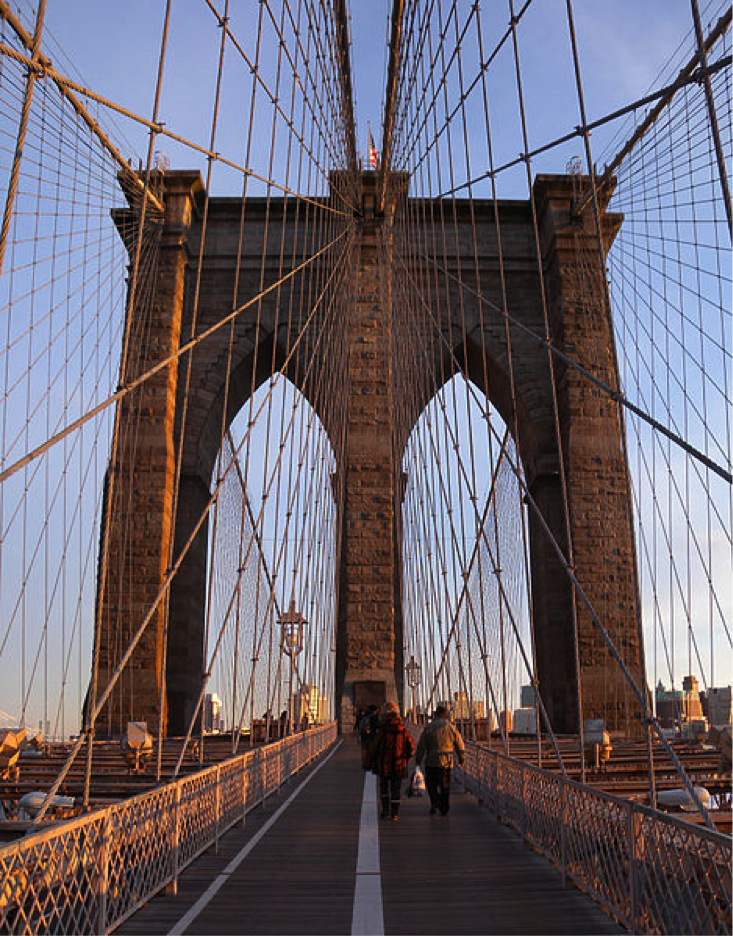 A Walk to the Brooklyn Bridge: Take a Scenic Tour from Maiden Lane to the East River
February 2, 2015
A Walk to the Brooklyn Bridge: Take a Scenic Tour from Maiden Lane to the East River
February 2, 2015
Are you wondering what it would be like to study English in New York? Have you ever thought about what a walk from the subway to your English school might look like? If you’re enrolled in classes at The New York English Academy, ideally located in the city’s Financial District, there are plenty of opportunities to explore the surrounding area’s rich architectural history. In this article we will guide you on a tour of iconic landmarks starting at our home on Maiden Lane and ending at one of the city’s most famous sites, the Brooklyn Bridge.

This relaxing walking tour can easily be done if you have a couple hours to spare, since the actual walking time is around 20–30 minutes. There is more to see than we can cover here, but we definitely suggest making the following locations a stop along the way.
Federal Reserve Bank of New York
Withdraw some gold from the Federal Reserve Bank of New York
Step out the front door of The New York English Academy, walk northwest on Maiden Lane, and you’ll see this building.
The Federal Reserve Bank of New York is the largest of the 12 reserve banks that make up “the Fed” (the Federal Reserve System), which sets monetary policy for the United States—the world’s largest economy. Guided tours are available though you have to make your reservations in advance. You can do so here up to 30 days in advance of your visit. On your tour, you will learn about the functions and history of the New York Fed as well as actually get a glimpse of the vault where the world’s largest store of gold bars is held.
St. Paul’s Chapel: New York’s colonial house of worship
After leaving the bank, head over to Broadway and go north for a couple blocks where you will encounter this building.
St. Paul’s Chapel, located at 209 Broadway between Fulton and Versey Streets, is the oldest surviving church building in all of Manhattan and has been in continuous use since 1766. The beautiful chapel is open to the public every day until 6 p.m. and there are regular free midday concerts. There are also several exhibitions in the chapel devoted to the events of September 11, 2001. The church yard is open until 4 p.m. on weekdays and 3:30 p.m. on weekends.
Newspaper Row: “Extra, extra, read all about it!”
Next, cross over Broadway and head east on Park Row. In its heyday it used to look like the picture below though significant changes have occurred since then.
This two-block stretch received the nickname “Newspaper Row” because many of New York City’s newspapers were headquartered here during the 1800s and early 1900s. This section of street runs from the junction of Bowery, East Broadway, St. James Place, Oliver Street, Mott Street, and Worth Street to the intersection of Broadway, Versey Street, Barclay Street, and Ann Street. The New York Times is headquartered at 41 Park Row and is the first building to be called a skyscraper. The Park Row Building at 15 Park Row, is also found here.
Take in the history of New York City Hall
After walking along the south side of Park Row, cross the street you’ll come to New York City Hall.
New York City Hall is located at the center of City Hall Park between Broadway, Park Row, and Chambers Street in the area commonly known as the Civic Center. This is the oldest city hall in the country where the municipal offices are still housed in the original building. There are more than a dozen monuments in the park around City Hall, so be sure to stop and learn some history while you’re walking by.
End your Lower Manhattan walking tour on the Brooklyn Bridge
Head east on the City Hall Park Path and this is where you’ll end up.
The Brooklyn Bridge is easily accessible via the promenade starting at City Hall Park, and the entire length of the bridge can be walked. Make sure to turn back and take in the cityscape view of lower Manhattan once you reach the Brooklyn side. It’s not to be missed!
Interesting facts about the bridge:
• It was finished and opened in 1883 though it didn’t get the official name “Brooklyn Bridge” until 1915.
• The total length of the bridge is 5,989 feet (1.83 km) so it will take you a little while to walk across unless you are quite a fast walker.
• According to the New York Department of Transportation, more than 4,000 pedestrians cross the bridge every day.
• If you’re a cyclist, you’ll be one of the 3,100 who cross the bridge daily so keep your eyes open and make sure to stay in the dedicated bike lane.
This is only a small taste of the many things to see in New York but we hope this has given you an idea of what life might be like if you decide to study English in the Big Apple. If you want to learn more about the area surrounding our school, check out our articles about Maiden Lane and Manhattan’s Financial District.
Archive
- October 2023
- August 2023
- July 2023
- June 2023
- May 2023
- April 2023
- March 2023
- February 2023
- January 2023
- November 2022
- October 2022
- August 2019
- July 2019
- June 2019
- May 2019
- April 2019
- March 2019
- February 2019
- December 2018
- October 2018
- September 2018
- August 2018
- July 2018
- June 2018
- May 2018
- April 2018
- March 2018
- February 2018
- January 2018
- December 2017
- November 2017
- October 2017
- June 2017
- April 2017
- March 2017
- February 2017
- January 2017
- December 2016
- November 2016
- October 2016
- September 2016
- August 2016
- July 2016
- June 2016
- May 2016
- April 2016
- March 2016
- February 2016
- January 2016
- December 2015
- November 2015
- September 2015
- August 2015
- July 2015
- June 2015
- May 2015
- April 2015
- February 2015
- January 2015
- November 2014
- October 2014
- September 2014
- August 2014
- July 2014
- June 2014
- May 2014
- April 2014
- March 2014
- February 2014
- January 2014
- December 2013
- November 2013
- October 2013
- September 2013
- August 2013
- July 2013
- June 2013
- May 2013
- April 2013
- March 2013
- February 2013
- January 2013
- December 2012
- November 2012
- October 2012
- September 2012
- August 2012
- July 2012





